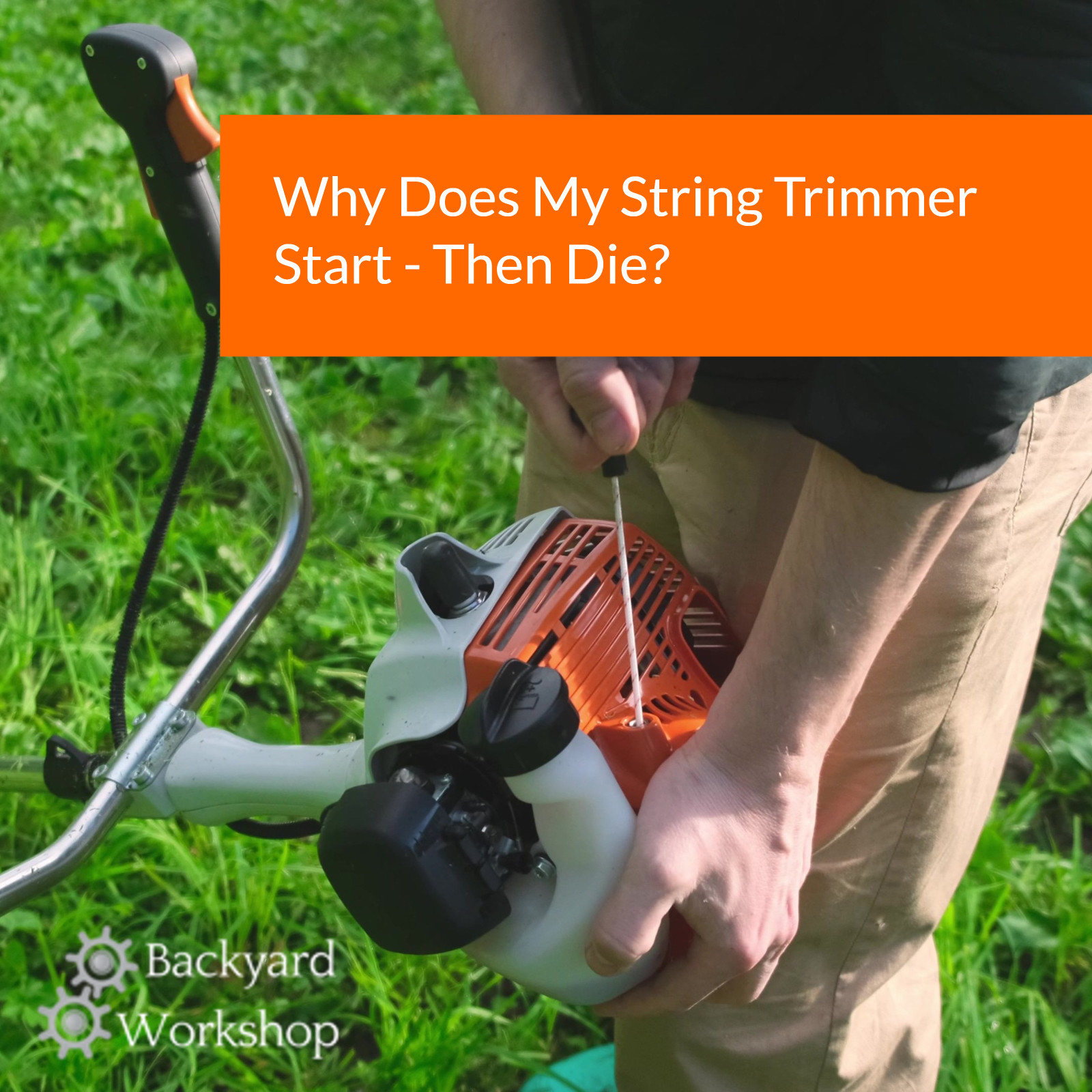Why Does My Weed Eater Die When I Give It Gas?

Have you ever given your weed eater gas, only for it to die? It’s a frustration many homeowners can relate to. So, what’s the cause?
Often, a weed eater can die due to a dirty fuel tank or using low-quality fuel. However, there’s good news. More often than not, you can troubleshoot and solve the issue with a few simple steps.
Read on to learn more about why your weed eater starts then dies when you give it gas and possible solutions to help you fix the problem.
Why Does My Weed Eater Start Than Die?
Here are some potential causes for a gas-powered weed whacker dying the minute you give it gas and a few possible solutions.
1. Bad Fuel Mixture
Remember, all gas isn’t universal as far as weed eaters are concerned. You might have the wrong fuel mixture or a bad fuel type. Your fuel tank may have water in it.
Using the wrong fuel in your weed eater is dangerous. It can cause severe damage to your machine’s internal components. A bad fuel mixture may allow your weed eater to start, but the equipment dies when you try to hit the throttle.
Apart from using the specific fuel that the manufacturer recommends, we advise always using ethanol-free gas. Although most models allow up to 10% ethanol usage, it’s not worth the risk. It could end up ruining your small engine.
If the problem lies with bad gas or the wrong fuel type, empty it immediately and refill it with the right mixture.
Consider Pre-Mixed Fuel
Consider using pre-mixed fuel like Husqvarna X. This fuel is not only ethanol-free, but it has a longer shelf life than homemade fuel mix. It also has a high octane rating.
Alternatively, you can use commercial pre-mixed fuel. These comprise fuel stabilizers at correct levels, and you can be sure of an accurate gas-to-oil ratio. Ultimately, it will help your small engine achieve optimum performance.
2. Worn Out Primer Bulb
If your gas tank shows sufficient gas levels and you have the correct fuel mix, then the primer bulb could be the problem.
First, check to ensure that it’s filing correctly before starting your small engine. Often, people forget to check this, but it’s an important step. Additionally, primer bulbs tend to wear out over time. So, ensure it’s not sucking in air when you depress it.
3. Restricted Fuel Filter Flow
A weed eater that dies upon throttling likely has a restricted fuel flow. Often, it’s because the fuel filter is clogged with impurities from gas.
Severe clogging means the filter only allows a small amount of fuel to pass through. The fuel allowed in may be too little to enable revving up, or it might allow your engine to start but die immediately after.
The solution is to clean or replace your fuel filter. Replacements are typically inexpensive and easy to install. Most importantly, if you mix your own fuel, always ensure the two-stroke oil you use is not expired.
4. Inadequate Air Intake – Dirty Air Filter
Your clogged air filter could also be contributing to an inadequate air intake. In a weed eater, fuel passes through the fuel filter and into the carburetor, where it mixes with the air.
However, if the air filter is restricted or clogged up, it chokes up the engine when you rev the throttle. Fixing this is not difficult.
Depending on the weed eater model you’re using, you might only need to turn a plastic knob, take off a screw, or remove the cover to access the filter. Once you can reach the air filter, you can either clean it or replace it if it’s too worn out. Like fuel filters, air filters don’t cost much.
5. Check the Carburetor
All gasoline engines have a carburetor. This engine component helps the air and fuel work together, ultimately igniting the combustion engine.
At the same time, a carburetor tends to be one of those small engine components that can cause frustration. In fact, most people who switch to electric tools cite this as the primary reason.
Some of the most common carburetor issues include the following.
Clogging
Sometimes, the carburetor may clog up, resulting in your weed whacker not revving after you start it. A commercial cleaner is typically sufficient to help clear the clog. After applying it onto the carburetor in thin, even strokes, allow it to settle and do its job.
Diaphragm
The diaphragm is a small piece on one side of the carburetor, comprised of small flaps. Check if these flaps are bent or worn out and, if necessary, replace them. There’s even a carburetor repair kit you can consult.
Metering Diaphragm
On the opposite side of the carburetor is another set of screws. If the issue was not with the diaphragm, unscrew the other set to assess the metering diaphragm’s situation.
This component of the carburetor regulates the engine speed. If it’s worn out or worn through, you’ll need to replace it. Replacing a metering diaphragm is an easy and inexpensive DIY project.
The Idle Speed
The engine may turn off shortly after starting it if the idle speed is too slow. If this is the case, it’s an easy fix.
Turn the screw associated with the idle speed to access it. Usually, it’s located behind the air filter, but you can confirm with your owner’s manual. It’s worth mentioning that adjustments should happen in ¼ turn increments.
After adjusting the idle speed, turn the string trimmer on again. Keep changing it until the problem no longer exists.
Exhaust Issues
Most people focus on the coming in of air and fuel and overlook the air getting out. Fortunately, this is also easy to rectify. All you need is to unclog the engine exhaust and clean it.
6. Problem With the Spark Plug
At times, a problem with the spark plug on your weed eater may be at fault for the gas not registering. Locate the covering of the spark plug. It should look like a protective case. You’ll want to educate yourself on removing the case and spark plug before doing so.
Follow these steps to remove your spark plug and check it:
- Remove the plastic cap over the top of the plug after lifting the spark plug cover.
- Wipe down the spark plug and areas around it, checking for dirt or other material in the fuel compartment.
- You’ll need a specific type of socket to remove the plug to check it or replace it.
- Remove any erosion or carbon deposits from the socket once you’ve removed it.
- You can use pliers to adjust the plug’s prongs if they’re bent or spaced unevenly.
- To test the plug, add it back to its compartment with the rubber tip, and see if the weed eater works better.
It may not be the problem if this doesn’t fix your weed eater. While working on your spark plug, ensure that nothing can get into the fuel tank or spark plug component by covering both.
Refer to Your Manual
When in doubt, refer to your user’s manual that comes with your weed eater. You can also check out a general weed eater troubleshooting guide for assistance. If the options on this list don’t work, consider hiring a professional who can assist you.
Keeping Your Weed Eater Revving and Running Properly
Now you should better understand why your weed eater starts then dies after giving it gas. Most of these issues are easily diagnosable, and the solutions are quick and inexpensive.
We recommend using a carburetor repair kit to work on common issues with weed eaters.
Do you have any questions or comments regarding this topic? Comment below if you’re interested in learning more.
It can be frustrating to work on a problem without apparent cause. Luckily, one of our six tips should do the trick.



![Best Corded Electric Weed Eater / Wacker Reviews - The Ultimate Guide For [FYear]](https://www.backyardworkshop.com/wp-content/uploads/./corded-electric-string-trimmer-400x296.jpg)
![The Best Weed Eater Reviews - For A Great Yard in [FYear]](https://www.backyardworkshop.com/wp-content/uploads/best-weed-wacker-2022-400x296.jpg)
